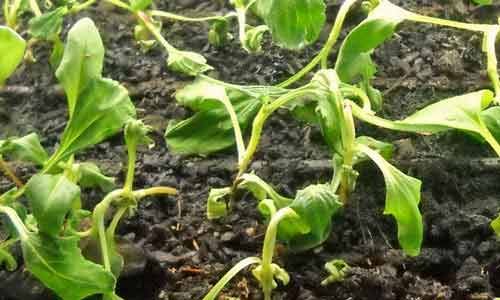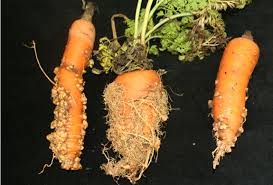Fighting soil diseases in our shamba can be a nightmare at times. With our tips, you can learn how to detect problems early and keep them out of your shamba.
Just like any other living organism, soil is susceptible to viruses, harmful fungi and bad bacteria, particularly when its out of balance. If in any case the soil in your farm is infected by the diseases below, your entire crops might be affected and it might also be very hard to fight them. The most important thing in keeping your soil and crops healthy is through protection and prevention. You can also use the tips below to detect and prevent diseases even if your farm doesn’t have them currently.
Soil diseases: Damping-Off
[caption id="attachment_2593" align="alignleft" width="500"] Plants affected by Damping off soil disease[/caption]
Plants affected by Damping off soil disease[/caption]
Its a fungus disease that mostly affects spinach, beets, low-growing seedlings, , chard, and lettuce. Damping-off typically attacks young plants, but can also affect germinating seeds, preventing germination from happening at all.
To prevent it, try Growing in high-quality soil with good drainage as it is one of the best way to prevent damping-off. As for seedlings, thin young plants to create better airflow, and don’t over water. Consider planting into sterilized soil or companion planting with garlic and chamomile, which have been known to help reduce the fungus. Once you have damping-off, lighten up on watering, preferably using a mister. Thin young plants and move them to a warmer area to encourage more rapid seed growth.
Read: Improving banana farming in Kenya through Value Addition
Soil Diseases: Verticillium Wilt
It’s a type of fungus. Crops affected include strawberries, potatoes, peppers, tomatoes and eggplant. Symptoms include leaves wilting and dying, typically from the soil upward.
To prevent it you can purchase wilt-resistant seeds, but also check any plants you buy for wilt, and never transplant a wilting plant into your garden. Verticillium wilt is very difficult to get rid of, though healthy, well drained soil will help. Soil polarization has been shown to reduce occurrences.
Soil Diseases: Downy Mildew
Downy mildew is caused by fungus. Affected crops include squash, cucumbers and other cucurbits; basil; grapes. Its symptoms may include; tiny yellow spots appear on leaves in early to late summer, killing the leaf canopy and making the fruit vulnerable to sun scorch.
How to Prevent It: Buy seeds resistant to downy mildew, and if irrigating, irrigate from below to keep the leaves as dry as possible. Rotate crop families every season, and cover the transplanted crops with row cover if you’ve experienced downy mildew in the past. There has been some success ridding downy mildew with bio-fungicides. We recommend farmers to dilute solution of copper spray to reduce the spread of the disease.
Soil Diseases: Powdery Mildew
Its caused by fungus. Crops Affected may include, squash, cucumbers and other cucurbits; roses; grapes.
Symptoms: Yellowish spots appear on the top of leaves and purple spots appear below, most commonly in warm, wet weather.
To prevent it, as with downy mildew, buy resistant seeds and irrigate from below to prevent creating a culture where powdery mildew can thrive. Row cover can help prevent bugs from transferring disease from plant to plant. Rotate crops each season.
This disease spreads easily among plants, so consider tearing out any affected plants and throwing them away. (Do not compost to avoid risk of spreading the disease.) Early applications of milk spray has also been shown to help prevent powdery mildew.
Soil Diseases: Bacterial Wilt
Its caused by a bacteria. The Crops Affected may include passion fruits, cucurbits, especially muskmelons and cucumbers. Symptoms include leaves wilting on the stems.To prevent it you can grow cultivars that are resistant to this wilt, but the best prevention is using row cover to keep cucumber beetles and other bugs from transmitting the disease.
There is no easy way to get rid of bacterial wilt. If you see the infection, remove the plants from your garden, especially passion fruits.
Soil Diseases: Foliar Nematodes
Affected Crops may include strawberries; ornamental crops, including asters, primrose, violets, ferns and dahlias. Symptoms might include yellow patches appear on leaves and may turn brown or black. Shoots may also become stunted and produce deformed flowers.To prevent it, Plant resistant cultivars, and always plant in well-drained soil with good air circulation. Clean up plant debris every season. Irrigate from beneath the plant if possible. How to Get Rid Of It: Destroy any affected parts of the plant. Thin plants if possible for better air circulation.
Read: 8 types of agribusiness ideas to think about in 2018
Soil Diseases: Root Knot Nematodes
[caption id="attachment_2592" align="alignleft" width="502"] Carrot affected by Rot Knot Nematodes[/caption]
Carrot affected by Rot Knot Nematodes[/caption]
It’s a nematode disease which affects thousands of crops , including corn, tomatoes, lettuce and potatoes. Its symptoms include wilting or yellowing plants; stunted fruits and flowers. To prevent root Knot nematodes plant resistant varieties when available. Marigolds, used as a cover crop and tilled into the soil at the end of the season, have been shown to help prevent the disease. Healthy soil full of organic matter will likewise help crowd out the nematodes.
Neem oil has been shown to help rid a garden of nematodes, though they are difficult to eradicate in the current season. Add compost and organic matter to soil at the end of the season to improve soil quality for the next year.
Soil Diseases: Bacterial Soft Rot
Its caused by bacteria. The affected crops include corn, potatoes, tomatoes, beans, carrots, sweet potatoes and onions. Bacterial soft rot primarily attacks tubers, rhizomes, bulbs and corms, creating black spots, yellow spots, a rancid odor and rot. It can also affect already harvested crops, including potatoes and carrots. To prevent it, plant in well-drained soils with good circulation. Keep areas around the garden, storage houses and greenhouse free of plant debris. There are no known remedies to get rid of it. Dispose of affected plants, and do not bury or compost.
Read: Reasons Why You Should Start an Agribusiness in Kenya Today
Soil diseases: Mosaic Virus
Its kind of a virus that affects potatoes, squash, tomatoes, cucumbers. This disease can affect both the leaves and fruit, appearing often as leaves with mottled yellow patches or stunted growth of the fruit with both green and yellow spots. To prevent it find mosaic-virus-resistant seeds, and shielding the plants with row cover helps prevent bugs from bringing the disease. In addition, always rotate crops. For you to get rid of it, tear up the plants and throw them away. Mosaic virus is highly contagious and can destroy a crop and spread to others.
Read: How Many Years Will It Take To Get Returns On Invested Capital Under Hass Avocado Farming
Soil Diseases: Scab
Its type of a fungus that affects mostly tuber crops such as such as potatoes, beets and radishes. This disease doesn’t usually affect the yield of a crop, but can blemish crops with small, rough, corky spots making them unsuitable for sale. To prevent it, lowering the soil pH to below 5.2 can help reduce the chances of scab. Purchase disease-free seed when available.
Because scab is generally discovered upon harvest, it’s hard to detect. Keep soil evenly moist and rotate crops every season to avoid the fungus.
Thank you for finding time to read this article. For more information about farming and how to control pests and diseases kindly contact us.











